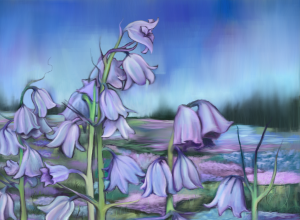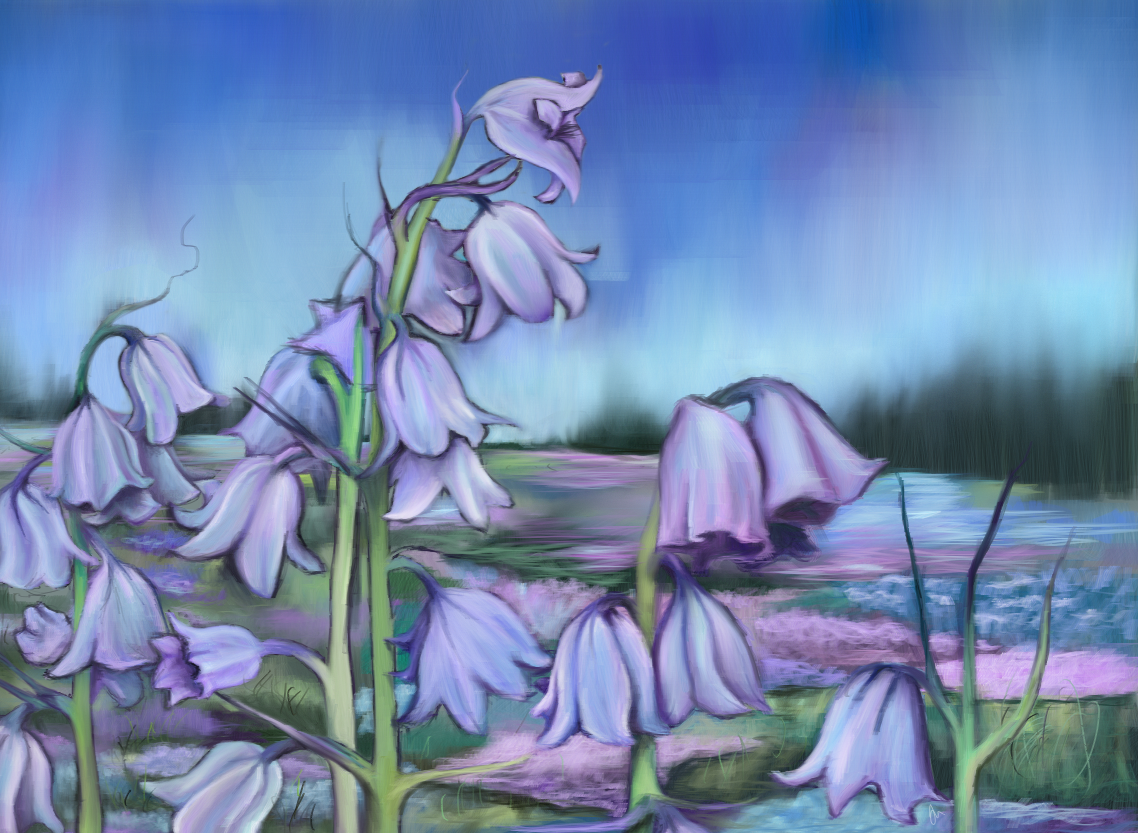An essay by Sidney Bover, as provided by Iris Wright
Art by Justine McGreevy
Stranded in fields of ultramarine flowers, I was paralyzed. The delicate blooms decorated the forest understory, so I, who was unable to swim, could drown in a sea of flowers with one wrong move. I looked down at my boots, but they were hidden beneath the plants. I exhaled. The wind blew through the trees. The thin stems trembled. At some point, I would have to move–I would have to find out if the flowers were poisonous.
I was no sufferer of anthophobia; I just had an extensive knowledge of dangerous plant hybrids. A professor once told me the more you know, the more prepared you may be, but you may also be more scared. I recalled the passage I read on bluebells from an outdated encyclopedia: “Hyacinthoides non-scripta die back completely and return the next year.” Bluebells, English or Spanish, were harmless until they were crossbred with poisonous plants. If I stood in a forest in 1820, or even in 2017, my caution was irrational. If it was a forest any year after 2314, the plants had been crossbred with several poisonous plants, and they would release toxic pollen into the air in response to the slightest disruption. A well-loved wildflower became a wicked plant. The toxic brand spread as rapidly as ordinary bluebells, covering the ground of surviving forests. Without so much as a scent indication, I would inhale life-ending chemicals.
It should have reassured me that my dilemma was a test, but the test was still real; I was still standing in a possibly toxic bluebell wood. If I passed the test–if I survived the test–I would earn my time traveling license. I would earn freedom to travel through all of space and time. It took me years of training to reach my final test. When I opened my eyes to the scene, my first impression of my setting was a harmless forest, but I minored in horticulture when I started out at the university. I knew I could be wading in treacherous waters. If I was clever enough, I could find out if I was in peril or just in a fairytale forest.
The stems bent in lax curves, the blooms weighing down the tooth-pick-thin stems, so they couldn’t be Hyacinthoides hispanica, or Spanish bluebells, which stood straight. They were a sweet blue, and their heads innocently nodded. If toxic, there would be a streak of pink on the inside of the petals. My view limited me to the outside of the downcast florets. If I knelt, I risked colliding with blooms. If they were poisonous, and I was fast enough, I could teleport from the location to a safer place. If they were harmless, there was no risk, and I could move through the forest until I met the real danger I was meant to face.
I avoided the thought that my advisors were watching my every move. If the plants were harmless, the observers may think I was too nervous to function under stress, which meant my license was far out of reach. If they were dangerous, my actions were perfect, but not if I underestimated the pollen’s speed.

I moved faster; if they were toxic, the dangerous chemicals in the pollen were already in the air. I dared not blink.
To read the rest of this story, check out the Mad Scientist Journal: Spring 2018 collection.
Sidney Bover entered the University of Southern Antarctica in the year 2578. After studying for a semester with an undecided major, he took an intro to time travel physics class and found his calling. After graduation, he intends to work at the Antarctic Time Travel Bureau. In his free time, Sidney grows potted vegetables, herbs, and annuals.
Iris Wright is a poet and short story writer from Plainfield, Illinois. She enjoys arranging flowers, canoeing, and dancing. Though she often experiments with genre and format, never settling for one style, she has an unwavering fascination with science fiction.
Justine McGreevy is a slowly recovering perfectionist, writer, and artist. She creates realities to make our own seem slightly less terrifying. Her work can be viewed at http://www.behance.net/Fickle_Muse and you can follow her on Twitter @Fickle_Muse.
“When Bluebells Die” is © 2018 Iris Wright
Art accompanying story is © 2018 Justine McGreevy
